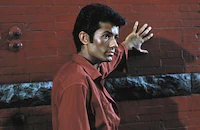Diamond Head

Brief Synopsis
Cast & Crew
Guy Green
Charlton Heston
Yvette Mimieux
George Chakiris
France Nuyen
James Darren
Film Details
Technical Specs

Synopsis
Richard "King" Howland, a ruthless and bigoted land monarch on the Hawaiian island of Kauai, is bitterly upset when his younger sister, Sloan, announces that she wants to marry a full-blooded Hawaiian, Paul Kahana, although he himself is having a clandestine affair with the native-born Mei Chen. At the young couple's engagement party, Mei Chen's drunken brother attacks Howland with a knife, and Paul is accidentally stabbed to death when he intercedes. Blaming her brother for Paul's death, Sloan refuses to speak to him and goes to Honolulu. There Paul's brother, Dean, finds her in a drunken stupor and takes her to live at his mother's home. A short time later, Mei Chen dies while giving birth to a son, but Howland refuses to accept the child, and Sloan decides to care for it. Following a fight with Howland, Sloan and Dean take the child and leave, but Howland, forced to accept the fact that he will soon have a halfcaste brother-in-law, finally decides to give his son the family name.

Director

Guy Green
Cast

Charlton Heston

Yvette Mimieux

George Chakiris
France Nuyen

James Darren

Aline Macmahon
Elizabeth Allan

Vaughn Taylor

Richard Loo
Marc Marno
Philip Ahn
Harold Fong
Edward Mallory
Lou Gonsalves
Frank Morris
Clarence Kim
Jack Matsumoto
Yankee Chang
Kam Fong Chun
Leo Ezell
Alan Lebuse
R. Ramos
Seagai Faumunina
Crew
John Aker
Pat Barto
Al Becker
Israel Berne
Jerry Bresler
Malcolm Brown
Frank Capra Jr.
Dick Cobes
Joseph Di Bella
James Z. Flaster
Charles Gibbs
William Kiernan
Willard Klug
Ben Lane
Sam Leavitt
Harold Lee
Rose Lehman
Eugene Lenoir
William A. Lyon
Frances Mcdowell
Andrew Mcintyre
Herbert E. Mendelson
Carol Michaels
Arthur Morton
Sam Nelson
M. B. Paul
William Randall Jr.
Charles J. Rice
Arnold Rich
Marguerite Roberts
Jack Roe
Charles Stapleton
Edna Taylor
Seldon White
Johnny Williams
Hugo Winterhalter

Videos
Movie Clip



Film Details
Technical Specs

Articles
Diamond Head
Ah, the French. "Acting" per se is not at issue here - movies are often comprised of energies and totemic factors that have nothing to do with character or story. Heston is indisputably one of those factors, a creature seemingly built for movies alone. Here he plays a symptomatic larger-than-life mega-man - Richard Howland, otherwise known as The King, the widowed, megalomaniacal patriarch of a massively wealthy, multigenerational white man's pineapple dynasty, faced with the prospect of running as Hawaii's first senator and with the region's uneasy graduation into postwar modernity. This manifests, inevitably, as conflicts about race, about the segregated native Hawaiian population clashing with the moneyed white ruling class Howland represents, and the story quite naturally puts this in Howland's lap as uncomfortably as possible: as an interracial romance, between a nice local "brown" boy (James Darren) and Howland's nubile college-age sister (Yvette Mimieux), for whom Howland clearly has some unresolved incestuous desire.
Like many Heston films, Diamond Head is about the odd spectacle of watching this megalithic demigod struggling to live among mortals and deal with mortal problems, and Heston's brawny Master of the Universe is absolutely uncomfortable, in ways another actor would have to fake, with miscegenation, race relations that aren't restricted to him lording it over the natives, and the very idea of his little sister having sex. The story, culled from Peter Gilman's big beach-read novel, catapults along to predictable confrontations, between Howland and nearly everybody, including George Chakiris as Darren's educated half-breed brother, but especially against Mimieux, whose kittenishness edges into vampy instability once Darren's heartthrob is accidentally killed during their engagement party, and her swoon into booziness leads her to sleep with Chakiris as well.
Obviously, the Hollywood reflex to cast patently un-native actors like Darren and Chakiris as Polynesians, and then surround them with fake-exotic examples of Hawaiian culture (dances, chants, aphorisms, legends) looks ridiculous today, and must be simply accepted as another earnest baby step the Industry made toward acknowledging, assimilating and celebrating ethnic paradigms that seemed foreign and primitive to the majority of white moviegoers. (Chakiris's hair, shaped more like a extraterrestrial's swollen brain than anything else, musters its own sense of alien-ness, compared to which the "brown" locals seem practically Anglo-Saxon.) Still, and fittingly for a civil-rights-era blockbuster, the narrative of Diamond Head is an overt protest against colonialism and white privilege; Howland becomes more of a rabid bigot the more he explains his tortured aversion toward "mixing," and can barely stop from exploding once his (of course) Hawaiian mistress (France Nuyen) announces that she's pregnant. Heston's almost spontaneous pronouncement of "For the love of God," when Mimieux announces a second set of interracial marriage plans, comes from deep within the volcano.
Rather organically, soap operatics and preachy talk about equality take over the plot, but not in an unpleasant way; movies like Diamond Head were as much mini-vacations and armchair travel for Americans, and here you can virtually see the late-'50s audience bellying up, in their cat glasses and black shoes, basking in a tropical-yet-all-American paradise where men are men, women have real sex with Asiatic hunks, and there's a stocked bar table in every room - even the horse stable. A hit in 1963 - right behind The Great Escape and a few slots ahead of the year's other Chuck-Heston-confronted-with-rebellious-Asians epic, Nicholas Ray's 55 Days at Peking - Diamond Head may have been forgotten today if it weren't for Heston, whose disarming and Homeric existence was a force, even before he opens his mouth, with which we may not yet have come to grips.
By Michael Atkinson

Diamond Head
Guy Green (1913-2005)
He was born on November 5, 1913 in Somerset, England. Long fascinated by cinema, he became a film projectionist while still in his teens, and was a clapper boy by age 20. He bacame a camera operator during World War II in such fine war dramas as One of Our Aircraft Is Missing; In Which We Serve (both 1942) and This Happy Breed (1944). His big break came as a director of photography came for Carol Reed's The Way Ahead (1944). He was eventually chosen by David Lean to photograph Great Expectations (1946), and his moody, corrosive look at Dickensian London deservedly earned an Academy Award. His work as a cinematographer for the next few years were justly celebrated. Film after film: Blanche Fury (1947), Oliver Twist (1948), The Passionate Friends (1949), Captain Horatio Hornblower R.N. (1951), The Beggar's Opera (1953), I Am a Camera (1955), all highlighted his gift for cloud-soaked period pieces with sweeping vistas of broad landscapes.
He made his directorial debut in a modest crime drama, River Beat (1954). Some minor titles followed: Portrait of Alison (1955); House of Secrets (1956); the ingenious mystery thriller The Snorkel (1958); the controversial child molestation drama The Mark (1961) starring Stuart Whitman in an Oscar® nominated performance; and his breakthrough picture, The Angry Silence (1960) which starred Richard Attenborough as an outcast who tries to battle labor union corruption. This film earned Green a BAFTA (a British Oscar equivilant) nomination for Best Director and opened the door for him to Hollywood.
Once there, he proceeded to make some pleasant domestic dramas: Light in the Piazza (1962), and Diamond Head (1963), before moving onto what many critics consider his finest work: A Patch of Blue (1965). The film, based on Elizabeth Kata's novel about the interracial love between a blind girl (Elizabeth Hartman) and a black man (Sidney Poitier) despite the protests of her bigoted mother (Shelley Winters), was a critical and commercial hit, and it earned Green a Golden Globe nomination for Best Director.
Strangely, Green would never enjoy a critical success equal to A Patch of Blue again. Despite his talent for sensitive material and handling of actors, Green's next two films: a forgettable Hayley Mills vehicle Pretty Polly (1967); and The Magus simply didn't attract the moviegoers or the film reviewers. He redeemed himself slightly with the mature Anthony Quinn-Ingrid Bergman love story Walk in the Spring Rain (1970); and the historical drama Luther (1973), before he stooped to lurid dreck with Jacqueline Susan's Once Is Not Enough (1975).
Eventually, Green would find solace directing a series of television movies, the best of which was an adaptation of the Arthur Hailey (of Airport fame) novel Strong Medicine (1986) starring Sam Neill and Annette O’Toole. Green is survived by his wife Josephine.
by Michael T. Toole
Guy Green (1913-2005)
Quotes
Trivia
Notes
Location scenes filmed in Hawaii. Richard Loo's participation is unconfirmed.

Miscellaneous Notes
Released in United States Winter January 1, 1962
Released in United States Winter January 1, 1962













